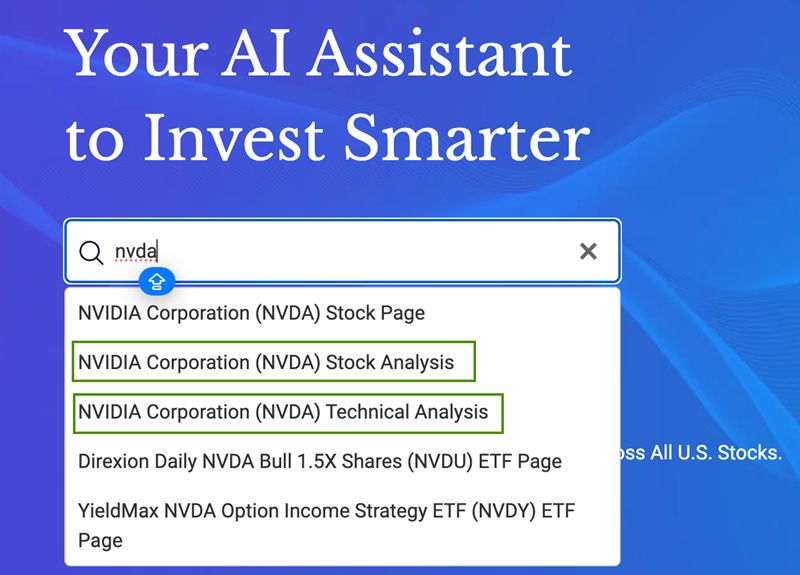Top 10 Ways To Assess Ai And Machine Learning Models For Ai Platform Analysis And Stock Prediction
In order to obtain accurate information, accurate and reliable You must test the AI models and machine learning (ML). Models that are not well-designed or exaggerated can result in inaccurate predictions and financial losses. Here are 10 of the most useful tips to help you evaluate the AI/ML models of these platforms.
1. Understanding the purpose of the model and the way to approach
A clear objective: determine whether the model was designed for short-term trading, long-term investing, sentiment analysis, or for risk management.
Algorithm disclosure: Check whether the platform is transparent about the algorithms it is using (e.g. neural networks or reinforcement learning).
Customization - See if you can tailor the model to meet your trading strategy and risk tolerance.
2. Examine the performance of models using measures
Accuracy - Examine the model's accuracy in predicting. But don't rely exclusively on this metric. It could be misleading on financial markets.
Accuracy and recall. Examine whether the model can accurately predict price changes and reduces false positives.
Risk-adjusted Returns: Check if a model's predictions result in profitable trades when risk is taken into consideration (e.g. Sharpe or Sortino ratio).
3. Check the model with backtesting
Backtesting the model by using previous data lets you test its performance against prior market conditions.
Tests with data that were not used for training To avoid overfitting, test the model using data that was not previously used.
Analysis of scenarios: Check the model's performance during various market conditions (e.g. bull markets, bear markets and high volatility).
4. Check for Overfitting
Overfitting signals: Look out for models that perform extraordinarily well with data training but poorly on data that is not seen.
Regularization methods: Determine whether the platform uses techniques like L1/L2 normalization or dropout to prevent overfitting.
Cross-validation: Ensure the platform uses cross-validation to assess the model's generalizability.
5. Evaluation Feature Engineering
Relevant features - Check that the model is using relevant features, like price, volume or technical indicators. Also, verify the macroeconomic and sentiment data.
Selected features: Select only those features which are statistically significant. Do not select redundant or irrelevant information.
Dynamic feature updates: Verify whether the model is able to adapt to changes in characteristics or market conditions in the course of time.
6. Evaluate Model Explainability
Model Interpretability: The model must give clear explanations of its predictions.
Black-box platforms: Be careful of platforms that use excessively complex models (e.g. neural networks that are deep) without explanation tools.
User-friendly insight: Determine whether the platform provides useful insights to traders in a manner that they are able to comprehend.
7. Test the adaptability of your model
Market changes: Determine if the model is able to adapt to changes in market conditions, such as economic shifts or black swans.
Examine if your platform is updating the model on a regular basis with new information. This will improve the performance.
Feedback loops. Be sure the model incorporates the feedback of users and real-world scenarios in order to improve.
8. Check for Bias or Fairness
Data bias: Make sure the training data is accurate to the market and free of biases (e.g. excessive representation of particular segments or timeframes).
Model bias: Find out whether the platform is actively monitoring and reduces biases in the predictions of the model.
Fairness: Ensure that the model doesn't unfairly favor or disadvantage certain stocks, sectors or trading strategies.
9. Evaluate the effectiveness of Computational
Speed: Find out whether your model is able to produce predictions in real-time or with minimal delay, especially for high-frequency trading.
Scalability Test the platform's capacity to handle large amounts of data and multiple users without performance loss.
Resource usage: Make sure that the model is designed to make optimal utilization of computational resources (e.g. the use of GPUs and TPUs).
10. Transparency in Review and Accountability
Model documentation: Ensure that the platform offers comprehensive documentation on the model's design, the process of training as well as its drawbacks.
Third-party auditors: Make sure whether the model has been subject to an audit by an independent party or has been validated by a third-party.
Error Handling: Check if the platform is equipped with mechanisms that detect and correct errors in the models or in failures.
Bonus Tips
Case studies and user reviews Utilize feedback from users and case studies to gauge the performance in real-life situations of the model.
Trial period: Try the model free of charge to determine the accuracy of it and how simple it is to utilize.
Support for customers: Make sure that the platform can provide an extensive customer service to assist you solve any product or technical issues.
Check these points to evaluate AI and ML stock prediction models to ensure that they are accurate and clear, and that they are in line with the trading objectives. Follow the recommended here are the findings about ai stocks for blog examples including ai trading tools, ai stocks, best ai stock trading bot free, ai investment platform, ai stock price prediction, ai investment app, getstocks ai, incite, best stock analysis website, ai stock trading app and more.

Top 10 Tips On How To Evaluate The Speed And Latency Of The Ai Stock Predicting/Analyzing Trading Platform
Latency and speed are important elements when it comes to considering AI stock predicting/analyzing trading platforms, particularly for algorithmic traders, active traders and high-frequency traders. A delay of just milliseconds can negatively impact profitability and trade execution. Here are ten top strategies to evaluate the speed and speed of these platforms.
1. Real-time Data Feeds to be used for evaluation
Speed of data delivery: Make sure the platform provides real-time data with a minimum delay (e.g., sub-millisecond latency).
Data source proximity - Look to see if the servers of your platform are within important exchanges. This will reduce data transmission times.
Data compression - Make sure that the platform uses efficient techniques for data compression to speed up data delivery.
2. Time to test trade execution
Processing orders: The platform's ability to process and execute trades fast after an order is submitted.
Direct Market Access (DMA) - Ensure that the platform supports DMA. This allows orders to be sent directly to the exchange, without the need for intermediaries.
Execution reports. Verify that the platform provides comprehensive execution reports. These reports must include dates for order submission, confirmation, and fill.
3. Examine Platform Response
User interface (UI also known as speed of user interface) The speed of user interface is the speed at which the platform's user interface responds to inputs you enter (e.g. pressing buttons or loading graphs).
Chart updates: Verify that charts and visualisations are updated in real-time and without delay.
Mobile apps' performance: When using a mobile application, make sure that it's just as fast as your desktop version.
4. Find low-latency infrastructure
Server locations: Make sure that the server is low-latency situated near major financial hubs or exchanges.
Co-location: If the platform offers co-location, you are able to host your trading algorithms on servers near the exchange.
High-speed Networks: Confirm the platform's use of a fiber-optic high-speed network or other technologies with low latency.
5. Evaluation of Backtesting and Simulation speed
Check how quickly the platform processes and analyzes historical data.
Simulating latency Make sure that the platform can simulate trades with minimal delay.
Parallel processing: Verify if your platform uses parallel or distributed computing to increase the speed of calculations.
6. Calculate API Latency
API response times: Determine how quickly APIs can respond to queries (e.g., fetching data from the platform, putting in orders).
Rate limits. Verify if there are reasonable limits for the API. This will assist in avoiding delays in high-frequency transactions.
WebSocket: Check whether the platform supports WebSocket protocols which permit streaming of data in real-time with low latency.
7. Test Platform Stability Under load
High-volume Trading: Simulate high quantities of trading scenarios in order to see if the platform is responsive and stable.
Check the platform during times of high volatility in the market to see if it is able to withstand rapid fluctuations in price.
Stress testing Test your strategy: Find out whether the platform allows users to test their strategy under extreme conditions.
8. Examine the network and connectivity
Speed requirements for Internet: Ensure your connection is up to the recommended speed for your platform.
Reliable connections: Check whether your platform has redundant internet connections. This will help you avoid downtime.
VPN latency - If you use a VPN for connection, be sure that it doesn't cause significant latency. Make sure that the platform provides alternatives.
9. Look for Speed Optimisation Features
Pre-trade analytics: Ensure the platform offers pre-trade analytics to optimize the routing of orders and speed of execution.
Smart order routing (SOR) Find out whether the platform utilizes SOR to identify the fastest and most cost-effective execution sites.
Monitoring latency Ensure that your platform lets you analyse and track your latency on a live basis.
Check out the feedback of users and benchmarks
User reviews: Read reviews from users to assess the platform's speed and performance.
Benchmarks provided by third parties: Look for reviews and benchmarks from independent sources which compare the performance of the platform to those of its competitors.
Case studies: Check if the platform provides case studies or testimonials highlighting the platform's low-latency capabilities.
Bonus Tips
Free trial period: Try the platform’s latency and speed in real-world scenarios using an online demo or trial.
Support for customers - Find out if there is support available to address problems related to latency, optimization or any other issue.
Hardware requirements: Determine whether you require specific hardware for optimal performance (e.g. high-performance PCs).
With these suggestions to evaluate the speed and latency of AI stock predicting/analyzing trading platforms, ensuring you choose the best platform for your requirements for trading and reduces the time it takes to complete. A low latency is essential for high-frequency and algorithmic traders. Even minor delays can have a huge impact on profitability. See the top rated a fantastic read on ai stock trading bot free for site recommendations including best ai etf, chart ai for trading, ai for stock trading, best stock analysis app, ai stock price prediction, ai stock picks, ai stock market, ai hedge fund outperforms market, ai copyright trading bot, stock analysis websites and more.

Comments on “20 Pro Ways For Choosing AI Stock {Investing|Trading|Prediction|Analysis) Sites”